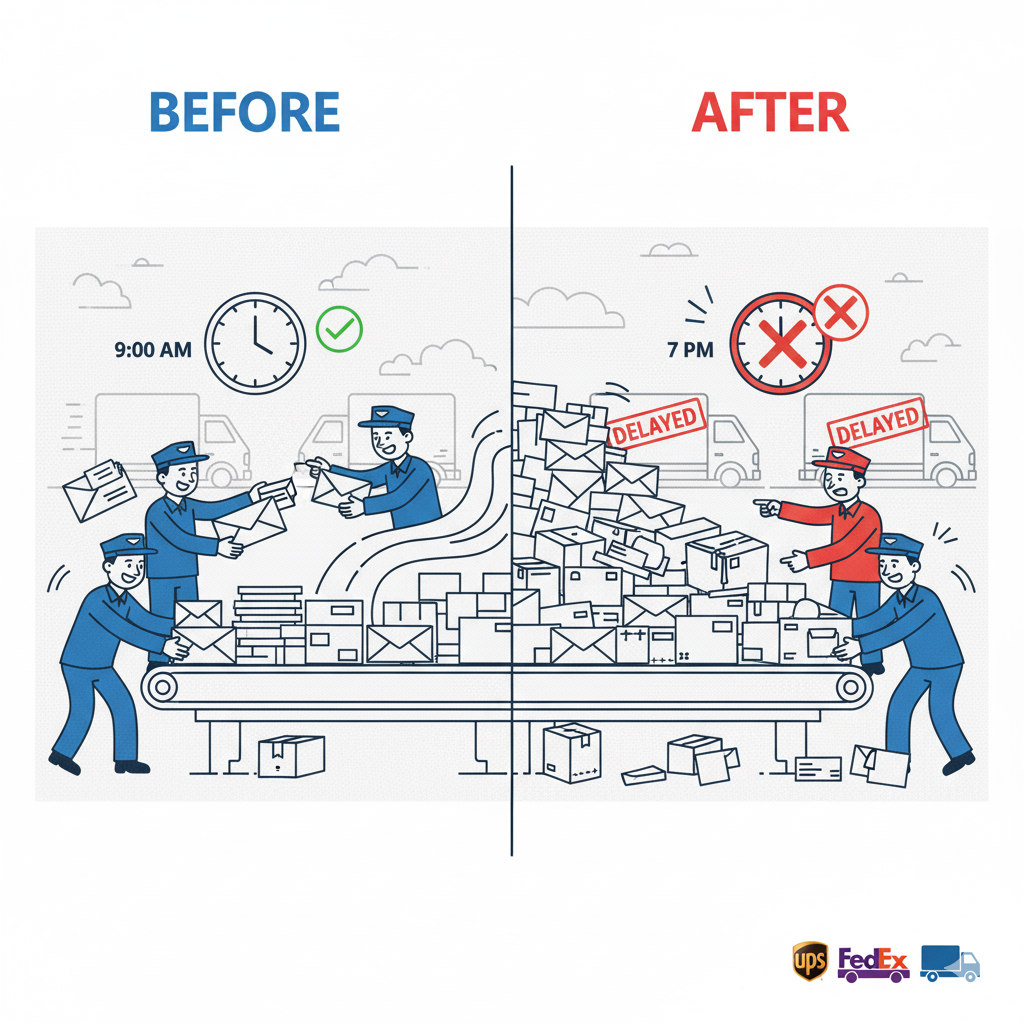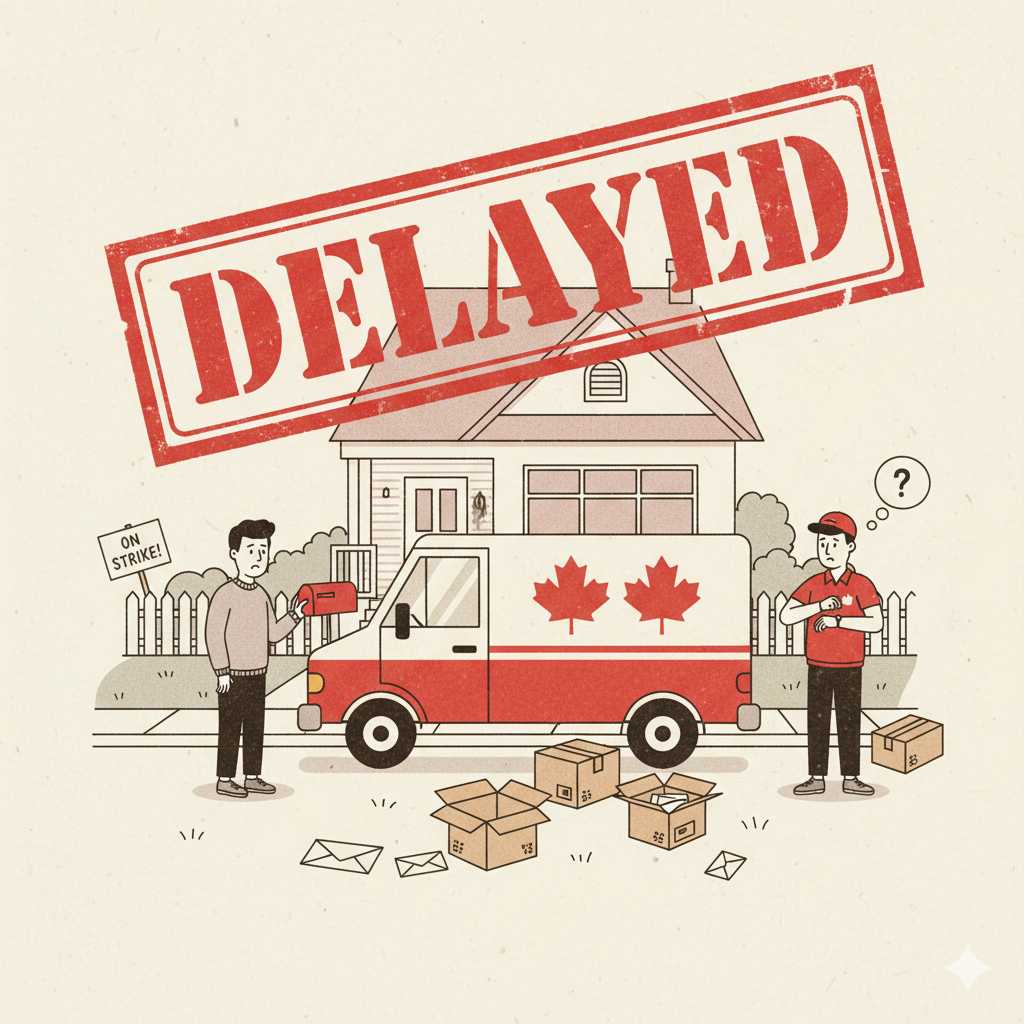You’re not alone if you’ve wondered why your mail seems to move more slowly than molasses in January. The Canada Post strike has been a real rollercoaster; frankly, it’s exhausting trying to keep up with all the twists and turns.
As someone tracking this mess since it started heating up again in 2024, I can tell you it’s been quite the journey. From the month-long strike that had us all scrambling before the holidays to the current overtime ban still causing headaches, there’s much to unpack here.
Let me walk you through everything you need to know about the Canada Post strike, what’s happening right now, and most importantly, how to deal with the ongoing mail delays without losing your sanity.
The Current State of Affairs: It’s Complicated
The Canada Post strike is still operating, but the Canadian Union of Postal Workers (CUPW) has implemented a national overtime ban as part of its legal strike action. This means employees refuse to work overtime across the company. This might not sound like a big deal, but trust me, it’s causing delays everywhere.
Think about it this way: imagine if everyone at your workplace suddenly decided to work only their exact scheduled hours and not a minute more. That’s what’s happening at Canada Post; the ripple effects are real.
The latest round of strike notices came in May 2025, with CUPW indicating they intended to begin strike activity as of May 23. That’s precisely what happened. The overtime ban kicked in, and here we are, months later, still dealing with the fallout.
A Quick Refresher: How We Got Here
Let’s rewind a bit. The big strike that got everyone’s attention began on November 15, 2024, and was suspended on December 17. If you were trying to send Christmas cards or gifts last year, you probably remember the absolute chaos that ensued.
I’ll never forget the panic in my local post office. People lined up around the block to find alternative shipping methods, and the staff looked like they’d rather be elsewhere. It was a mess, but somehow we all survived the holiday season.
The Canada Industrial Relations Board (CIRB) ordered postal workers to return to work on December 17, 2024, which gave us all a brief sigh of relief. But as we’ve learned, that wasn’t the end of the story.
What’s Really Behind All This Drama?
Here’s what I’m about this situation: it’s just about money. Sure, wag part of the issue, but the deeper problems affect everyone who uses Canada Post.
The union has been clear that the overtime ban shows us what’s to come if Canada Post strike gets their way with the collective agreements, which would mean more part-time positions and continued overtime restrictions.
From what I’ve gathered, the main sticking points include:
- Working conditions and job security
- The role of overtime in daily operations
- How to handle the increasing demands of package delivery
- Fair compensation for the work being done
It’s not just about postal workers wanting more money (though fair pay is essential). It’s about the future of postal services in Canada and how we want them to function.
The Real Impact of the Canada Post Strike on Your Daily Life
Let’s get practical for a minute. What does this actually mean for you and me?
Mail Delays Are the New Normal
Since the overtime ban started, I’ve noticed my mail arriving later and less predictably. That Amazon package that used to show up like clockwork? It might take an extra day or two now.
Because CUPW-represented employees refuse to work overtime, customers are experiencing delays even though Canada Post strike continues operating. It’s not a complete shutdown, but not a bus, in business as usual.
Business Owners Are Feeling the Pinch
If you run a small business that relies on mail delivery, this has probably been a nightmare. I’ve talked to several local business owners who’ve had to rethink their shipping strategies completely. Some have switched to private couriers for urgent deliveries, while others spend extra time aging customer expectations.
Online Shopping Considerations
This is where it gets personal for most of us. That “free shipping” option that takes forever anyway? It’s going to take even longer now. You might want to consider:
- Choosing expedited shipping for time-sensitive items
- Using alternative delivery services when available
- Planning for any gifts or important mailings
Navigating the Mail Delays: Tips from Someone Who’s Been There
After dealing with this situation for months, I’ve picked up some strategies that actually work:
1. Track Everything Obsessively
I know it sounds obvious, but seriously, track every package. The Canada Post strike tracking system has become my new best friend. Sure, it might not update as frequently as we’d like, but at least you’ll know where your stuff is.
2. Use Alternative Services When It Makes Sense
Don’t be afraid to use UPS, FedEx, or other courier services for urgent documents or gifts. Yes, it costs more, but sometimes peace of mind is worth the extra expense.
3. Communicate Early and Often
If you expect something important, inform the sender about potential delays upfront. If you’re sending something time-sensitive, notify people that it might take longer than usual.
4. Plan (Like, Way Ahead)
Remember how our parents used to start Christmas shopping in July? They might have been onto something. With ongoing postal delays, planning isn’t just thoughtful – it’s essential.
The Business Side: What Companies Are Doing
I’ve been curious about how businesses adapt, so I’ve dug. Here’s what I’ve found:
Many online retailers have started offering more shipping options and being upfront about potential Canada Post strike delays. Some have partnered with alternative delivery services, while others are building extra time into their delivery estimates.
Local businesses have also gotten creative. I’ve seen more “pickup available” options, partnerships with local delivery services, and even some companies offering hand-delivered items within specific areas.

Looking Ahead: What Might Happen Next?
This is where it gets tricky to predict. The union has indicated that the overtime ban will stay in place during ongoing negotiations, with the outcome potentially depending on the results of forced final offer votes.
Based on everything I’ve read and observed, here are a few possible scenarios:
Scenario 1: Negotiated Settlement. The most optimistic outcome would be for both sides to reach an agreement that addresses the core issues. This likely means a gradual return to normal service levels.
Scenario 2: Escalation. If negotiations continue to stall, we could see more serious job action, including rotating strikes or a complete work stoppage.
Scenario 3: Government Intervention. Given the critical nature of public services, government intervention to force a resolution is always possible.
What You Can Do Right Now About the Canada Post Strike
While we can’t control the outcome of these negotiations, we can control how we respond:
For Personal Mail:
- Switch to electronic billing and statements where possible
- Use email for non-urgent communication
- Plan for any important mailings
For Packages:
- Compare shipping options before ordering online
- Consider consolidating orders to reduce the number of shipments
- Use pickup points or post office boxes if available
For Business:
- Diversify your shipping options
- Communicate clearly with customers about potential delays
- Consider local delivery alternatives
The Silver Lining (Yes, There Is One)
Despite all the frustration, this situation has highlighted some interesting things about how we use postal services. Many people have become more conscious about their mailing habits and have found creative alternatives.
I’ve also noticed a greater appreciation for postal workers and their work. When you can’t rely on something being there, you realize how much you took it for granted.
Staying Informed Without Going Crazy
Here’s my advice for staying up to date without becoming obsessed with every development:
- Check official sources once a week: Both Canada Post strike and CUPW post updates on their websites
- Set up news alerts, but limit them to avoid information overload
- Focus on what you can control: Your shipping choices, timing, and backup plans
Frequently Asked Questions
Q: How long will the Canada Post strike last?
A: There’s no definitive end date. The current overtime ban has been in effect since May 2025, and it will continue until a new collective agreement is reached between Canada Post strike and CUPW.
Q: Are all postal services affected by the strike?
A: The overtime ban affects the entire Canada Post strike network, but services are still running with potential delays. Express and priority services may be less affected than regular mail.
Q: Can I get a refund for delayed packages?
A: Canada Post strike’s refund policies for strike-related delays vary depending on the service you used. For specific situations, check their website or contact customer service.
Q: What’s the difference between an overtime ban and a full strike?
A: An overtime ban means workers only work their regular scheduled hours and refuse overtime. A complete strike means workers don’t work at all. The overtime ban allows services to continue, but often with reduced capacity.
Q: Should I avoid using Canada Post strike entirely?
A: Not necessarily. The Canada Post strike is still functioning for non-urgent items. However, consider alternatives for time-sensitive deliveries.
Q: How can I track the progress of negotiations?
A: Both Canada Post strike and CUPW post updates on their official websites. Canadian news outlets also cover significant developments.
Q: Are PO boxes affected by the strike action?
A: PO box service continues, but deliveries to PO boxes may be delayed due to reduced processing capacity from the overtime ban.
Q: What should businesses do about shipping delays?
A: Be transparent with customers about potential delays, offer alternative shipping methods where possible, and consider adjusting delivery time estimates to account for current conditions.
The Bottom Line
The Canada Post strike situation is frustrating, but it’s not insurmountable. While workers aren’t holding rotating or nationwide strikes, the job action involving refusing overtime impacts service.
Your mail might be slower, and you may need to plan more than usual. But we can all navigate this together with flexibility and strategic thinking.
The most important thing is to stay informed without getting overwhelmed, have realistic expectations about delivery times, and remember that this situation won’t last forever. Every labor dispute eventually gets resolved; it’s just a matter of when and how.
In the meantime, this is a good opportunity to rediscover the lost art of planning ahead, or to finally switch to digital alternatives you’ve been putting off. Sometimes a little disruption can push us to make positive changes we should have made anyway.
Whether you’re a regular person trying to get your packages delivered or a business owner dealing with shipping challenges, the key is adaptation. We’ve all experienced postal strikes before, and we’ll get through this today. Today, I’m informed, and remember your mail carrier is just as frustrated with this situation as you are. A little understanding goes a long way, especially during times like these.
This article will be updated as the situation develops. For the most current information, please check the official Canada Post strike and CUPW websites.
